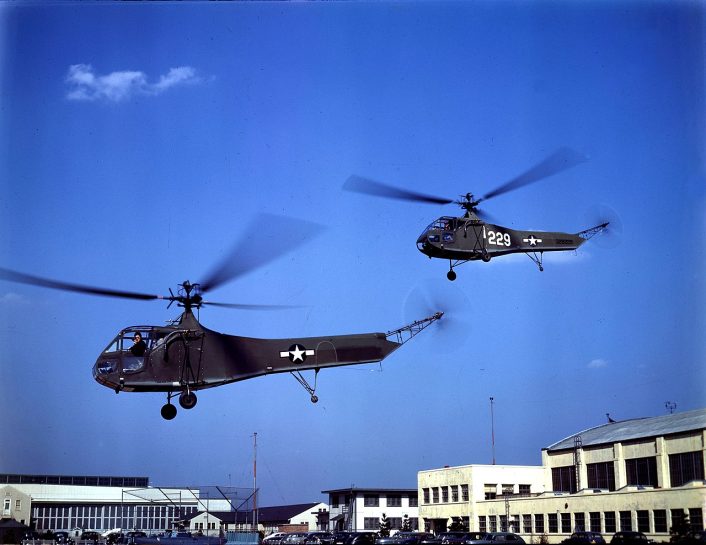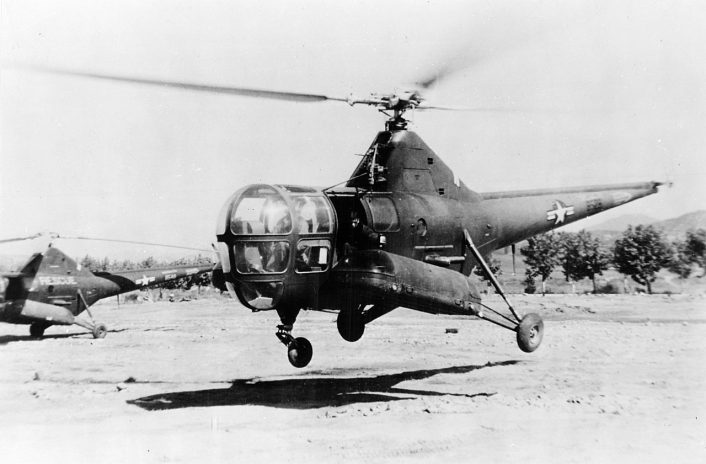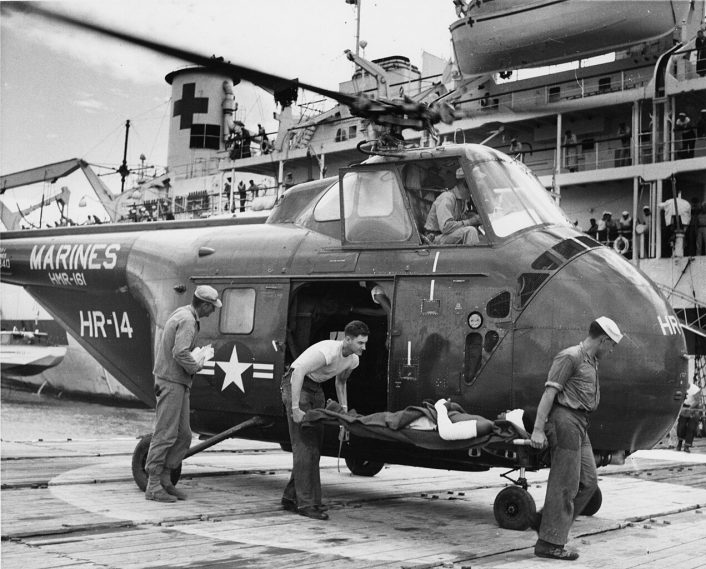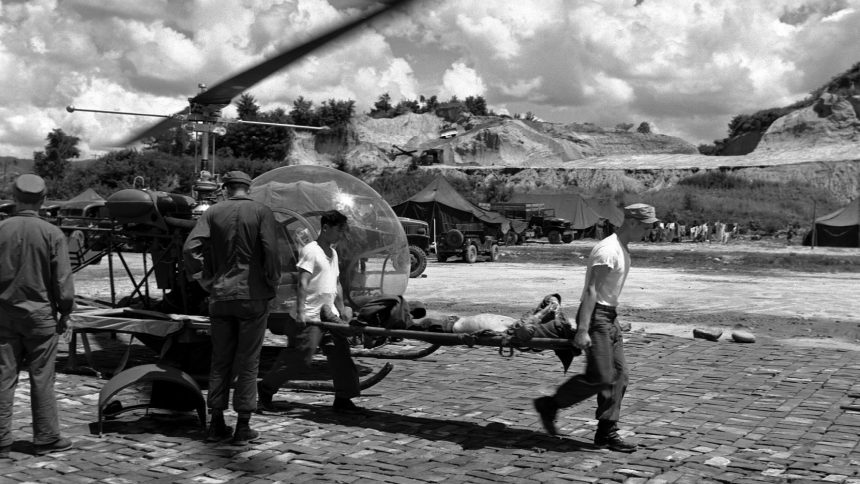The use of helicopters at the end of World War Two for medical evacuations (MEDEVAC) proved the machine’s usefulness in getting into tight spots in isolated and rugged terrain, increasing the ability to provide prompt medical attention, and saving lives. Their use would increase and improve with each subsequent conflict the US military found itself involved in.
“You look like an angel!” said the downed American pilot Sgt. Murphy Hladovack to Lt. Harman. Harman had just landed his Sikorsky YR-4 service test model helicopter near a stricken Stinson L-1 liaison aircraft. Hladovack was flying three British casualties from the jungles of Burma in April 1944, when forced down in an isolated jungle location behind Japanese lines. With no way to reach the four downed men, Harman and his helicopter had been summoned to the scene.
The Japanese were aware the L-1 went down and were hunting the pilot and passengers. Time was of the essence, and there was no way to land a conventional aircraft in the area or to reach the stranded men on the ground with enemy troops infiltrating the area.
The helicopter had never been used for this type of operation before, and the YR-4 (later designated the R-4 service model) was a rather small aircraft, with only room for a pilot and one additional person. It had a top speed of around 75 mph, and maximum altitude of 8,000 ft. The range of the helicopter was 130 miles. The machine was difficult to fly, and the heat, humidity, and high elevations of the Burmese jungle made it even more difficult. The thin air reduced the lifting capacity.
Harman planned to take the men out one at a time, deposit them in an area accessible to conventional aircraft, and they would then be flown to safety. With the thin air, it was all he could do to get the helicopter airborne with one of the injured onboard. The operation strained the delicate craft, and on the second trip, the engine overheated on the way out and Harman had to stop for the day. The engine eventually seized and could not be restarted.
The next morning Harman was able to get the engine running again and was able to rescue the other two men trapped in the jungle with the Japanese closing in on them. While the introduction of the helicopter into military service had been met with criticism because of its slow speeds and apparent fragility, Harman had proven the machine’s worth in rescuing and evacuation of the wounded. He went on to perform more rescue missions in the jungles, as well as other pilots using the R-4 before the close of the war.

Earning Their Wings in Korea
When North Korean troops crossed the 38th parallel on June 25, 1950, the United States had still not clearly defined the roles of the helicopter in time of conflict. There was still no model or configuration dedicated to the transportation of the wounded.
The most abundant helicopter in service at the time was the Sikorsky H-5. The H-5 was designed for a pilot and co-pilot, and had a bench for up to three passengers. Crews would remove one of the windows allowing a stretcher to fit with the wounded hanging out from the knees down. The machine was used to rescue the wounded from hilltops and other areas jeeps could not reach, taking them quickly to hospitals for treatment.
The H-5 would also be fitted with stretcher pods attached alongside the fuselage allowing transport of two patients. It had a top speed of 106 mph, a service ceiling of 14,400 ft., and a range of 360 miles.

Perhaps the most well-known helicopter used in Korea was the Bell H-13, a small three-seat workhorse with an exposed engine and a skeletal tail section, and a very distinguished bubble canopy. The H-13 was also fitted with external litters, one on either side of the helicopter atop the landing skids. The litters had a clear windscreen that fit over the patient’s head and shoulder area to protect them from wind and flying debris. Holes in the fuselage allowed transfusing system tubes to be run outside to the litters, with the bags hung inside the cabin. The helicopter had no windshield wipers or interior instrument panel lighting, in order to see the gauges during night operations the pilots held flashlights between their knees since both hands were on the controls, and forced to hang their heads out the side of the canopy in inclement weather to see ahead. The H-13 had a top speed of 105 mph, service ceiling of 16,100 ft., and a range of 273 miles.
The H-13 dubbed the “Angel of Mercy” was often attached directly to MASH (Mobile Army Surgical Hospital) units. The idea behind the MASH units was to have a mobile hospital complete with surgeons, anesthesiologists, nurses and equipment close to the lines in order to speed up the time required to get casualties treated. The plan worked, using the MASH units and the attached H-13s, the time needed to get the wounded to treatment went from several hours or even days to in some cases an hour or less. This dramatically increased the survival chances of casualties.

Another small helicopter used in Korea was the Hiller H-23 Raven. The Raven was a light helicopter with a crew of two, maximum speed of 95 mph, range of 197 miles, and service ceiling of 13,200 ft. Like the H-13, litter pods were fastened externally to the landing skids for medevac operations. Versions of the H-23 served with the US Army and Navy and it was widely exported as well.
The Sikorsky H-19, a larger transport helicopter, was also used in Korea for medevac operations. It could carry out up to six casualties along with a nurse or medical technician, and could carry large medical supply loads into drop zones. The H-19 soon surpassed the H-5 in casualty evacuations and was in use by the United States Air Force into the 1960’s, and found a home with all the branches of the US military as well as the Coast Guard. It had a top speed of 101 mph, range of 450 miles, and service ceiling of 10,500 ft. Over 1,700 were built.
At times, due to the danger of the mission, a rescue operation would turn into a MEDEVAC situation. One example occurred on a cold day in 1953.
Major David Cleeland was flying his F4U Corsair while attacking a North Korean bridge and was hit by ground fire. He was forced to make a wheels-up landing behind enemy lines on a frozen lake. After spinning crazily on the ice, Cleeland discovered he was surrounded by enemy troops. Other Corsairs circled overhead and radioed for a rescue team. Cleeland hid behind his aircraft, fashioned a makeshift dummy with his parachute and helmet; using it to occupy the fire of the enemy troops. After about an hour, an H-19 of the US Air Force appeared on scene and prepared to rescue the downed pilot. One of the remaining airborne Corsairs had to strafe an attacking cavalry charge on horseback across the ice as the helicopter sat down near Cleeland’s location. Airman Thomas C. Thorton, onboard the H-19, shouted to Cleeland to run to the chopper, with Cleeland finally braving the enemy fire and making a dash for it. As Cleeland ran a bullet hit him in the leg but he kept going, reaching for the outstretched hand of Thorton, just as a bullet struck Thorton’s hand. Without hesitation, Thorton simply extended his other hand hoisting the pilot aboard. The helicopter then whisked the two now wounded men away to safety, the helicopter suffering a shot away wheel, rotor damage, and a hit in a fuel tank.

Over 20,000 casualties were transported by helicopters during the Korean conflict, and because of the speed of evacuation, and the implementation of the MASH units, the reduction in death rates of Army evacuated patients before reaching medical facilities improved from 4.5 percent in the previous war down to 2.5 percent. Overcoming the difficult terrain, getting in where wheeled vehicles or fixed wing aircraft could not, the helicopter in Korea had fundamentally changed the way the military would now evacuate the wounded, in spite of a shortage of machines, spare parts, and constant harassment from the enemy. Lessons learned would be applied to the next war, one known as the “Helicopter War” in Southeast Asia, and into modern warfare, the subjects of an upcoming article.
The second part of this report, “Angels With Rotors Part 2: U.S. MEDEVAC Helicopter Operations From Vietnam to Present Day” can be found here.









